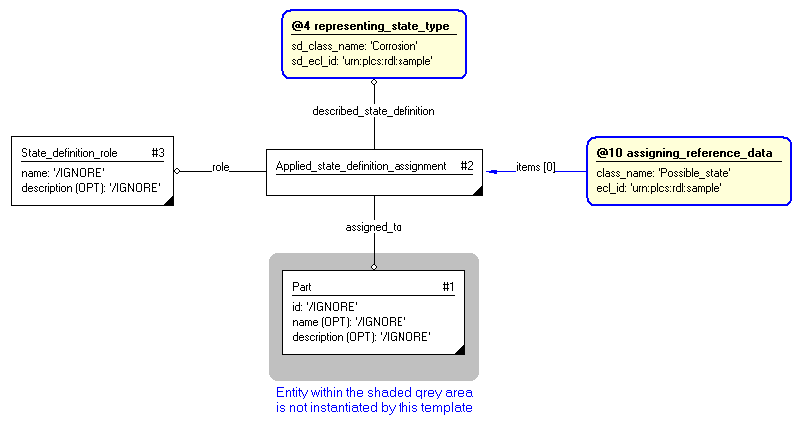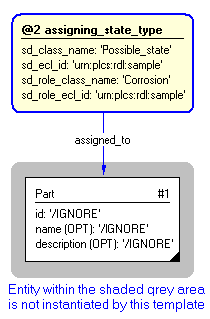
| Template:— assigning_state_type (asg_state_type) | Date: 2009/04/03 08:58:01 Revision: 1.14 |
This section specifies the template assigning_state_type.
NOTE An explanation of a template and the associated instantiation path is provided in the Template overview section.
This template describes how to represent state definitions (types of states), how to assign the state definition to something, and how to reference a state definition within a data set.


target
is the parameter to which the
Applied_state_definition_assignment
is bound.
target
is the parameter to which the
State_definition
is bound.
| Entity in path | Value | Inherited from |
| State_definition_role.name | '/IGNORE' | — |
| State_definition_role.description | '/IGNORE' | — |

#1 = PART('/IGNORE','/IGNORE','/IGNORE'); #3 = STATE_DEFINITION('/IGNORE','/IGNORE'); #4 = STATE_DEFINITION_ROLE('/IGNORE','/IGNORE'); #5 = APPLIED_STATE_DEFINITION_ASSIGNMENT(#3,#1,#4); #7 = CLASSIFICATION_ASSIGNMENT(#9,(#3),'/IGNORE'); #9 = EXTERNAL_CLASS('/NULL','Corrosion','/IGNORE',#10); #10 = EXTERNAL_CLASS_LIBRARY('urn:plcs:rdl:sample',$); #12 = CLASSIFICATION_ASSIGNMENT(#14,(#5),'/IGNORE'); #14 = EXTERNAL_CLASS('/NULL','Possible_state','/IGNORE',#10);

NOTE this characterization is optional.
Descriptions can be assigned to the State_definition using assigning_descriptor, e.g. in order to describe a state type that than can be classified. This is useful e.g. in creating a Failure Modes and Effects and Criticality Analysis (FMECA).
NOTE this characterization is optional.
Justifications can be assigned to the Applied_state_definition_assignment using assigning_justification, e.g. in order to define the circumstances that justifies a possible state.
This has been raised as issue, GYL-2, against ISO 10303-239. The EXPRESS schema has been modified in DEXlib (Long form: dexlib/data/schemas/ap239_arm_lf.exp, short form: dexlib/data/schemas/ap239_arm_sf.exp). These changes will be made to ISO 10303-239 as a Technical Corrigendum at some stage.
NOTE this characterization is optional.
Activities can be assigned to the Applied_state_definition_assignment using assigning_activity, e.g. in order to describe activities/events that may be a consequence of a defined state type.
© OASIS 2010 — All rights reserved